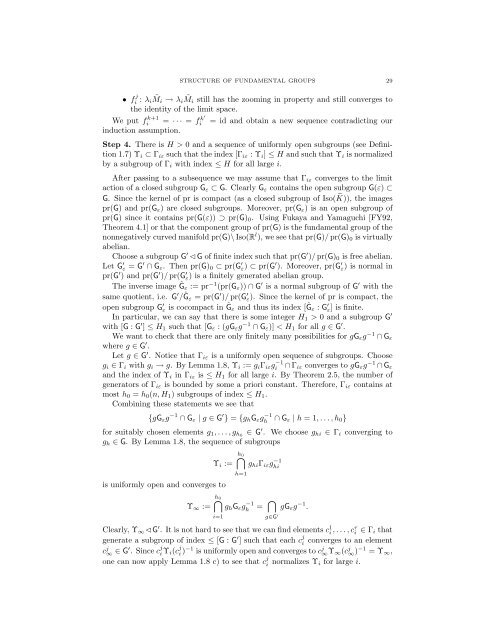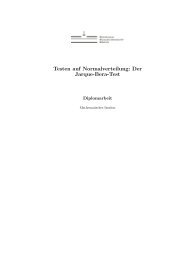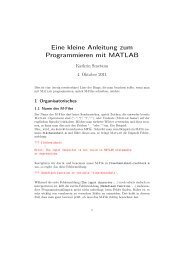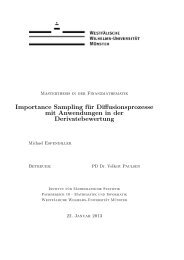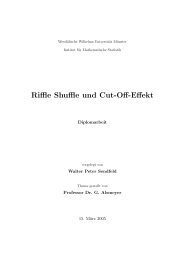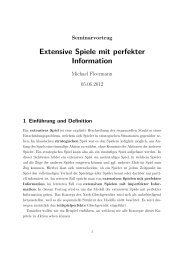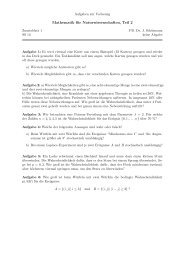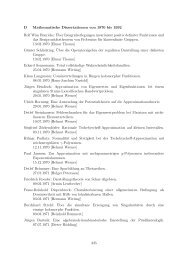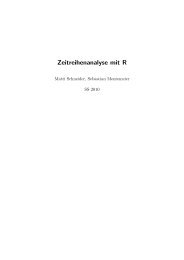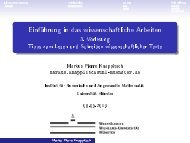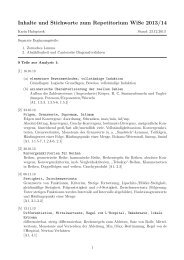Margulis Lemma
Margulis Lemma
Margulis Lemma
Create successful ePaper yourself
Turn your PDF publications into a flip-book with our unique Google optimized e-Paper software.
STRUCTURE OF FUNDAMENTAL GROUPS 29<br />
• f j i : λ ˜M i i → λ i ˜Mi still has the zooming in property and still converges to<br />
the identity of the limit space.<br />
We put f k+1<br />
i = · · · = fi<br />
k′ = id and obtain a new sequence contradicting our<br />
induction assumption.<br />
Step 4. There is H > 0 and a sequence of uniformly open subgroups (see Definition<br />
1.7) Υ i ⊂ Γ iε such that the index [Γ iε : Υ i ] ≤ H and such that Υ i is normalized<br />
by a subgroup of Γ i with index ≤ H for all large i.<br />
After passing to a subsequence we may assume that Γ iε converges to the limit<br />
action of a closed subgroup G ε ⊂ G. Clearly G ε contains the open subgroup G(ε) ⊂<br />
G. Since the kernel of pr is compact (as a closed subgroup of Iso( ˜K)), the images<br />
pr(G) and pr(G ε ) are closed subgroups. Moreover, pr(G ε ) is an open subgroup of<br />
pr(G) since it contains pr(G(ε)) ⊃ pr(G) 0 . Using Fukaya and Yamaguchi [FY92,<br />
Theorem 4.1] or that the component group of pr(G) is the fundamental group of the<br />
nonnegatively curved manifold pr(G)\ Iso(R l ), we see that pr(G)/ pr(G) 0 is virtually<br />
abelian.<br />
Choose a subgroup G ′ ⊳ G of finite index such that pr(G ′ )/ pr(G) 0 is free abelian.<br />
Let G ′ ε = G ′ ∩ G ε . Then pr(G) 0 ⊂ pr(G ′ ε) ⊂ pr(G ′ ). Moreover, pr(G ′ ε) is normal in<br />
pr(G ′ ) and pr(G ′ )/ pr(G ′ ε) is a finitely generated abelian group.<br />
The inverse image Ĝε := pr −1 (pr(G ε )) ∩ G ′ is a normal subgroup of G ′ with the<br />
same quotient, i.e. G ′ /Ĝε = pr(G ′ )/ pr(G ′ ε). Since the kernel of pr is compact, the<br />
open subgroup G ′ ε is cocompact in Ĝε and thus its index [Ĝε : G ′ ε] is finite.<br />
In particular, we can say that there is some integer H 1 > 0 and a subgroup G ′<br />
with [G : G ′ ] ≤ H 1 such that [G ε : (gG ε g −1 ∩ G ε )] < H 1 for all g ∈ G ′ .<br />
We want to check that there are only finitely many possibilities for gG ε g −1 ∩ G ε<br />
where g ∈ G ′ .<br />
Let g ∈ G ′ . Notice that Γ iε is a uniformly open sequence of subgroups. Choose<br />
g i ∈ Γ i with g i → g. By <strong>Lemma</strong> 1.8, Υ i := g i Γ iε g −1<br />
i ∩ Γ iε converges to gG ε g −1 ∩ G ε<br />
and the index of Υ i in Γ iε is ≤ H 1 for all large i. By Theorem 2.5, the number of<br />
generators of Γ iε is bounded by some a priori constant. Therefore, Γ iε contains at<br />
most h 0 = h 0 (n, H 1 ) subgroups of index ≤ H 1 .<br />
Combining these statements we see that<br />
{gG ε g −1 ∩ G ε | g ∈ G ′ } = {g h G ε g −1<br />
h ∩ G ε | h = 1, . . . , h 0 }<br />
for suitably chosen elements g 1 , . . . , g h0 ∈ G ′ . We choose g hi ∈ Γ i converging to<br />
g h ∈ G. By <strong>Lemma</strong> 1.8, the sequence of subgroups<br />
Υ i :=<br />
is uniformly open and converges to<br />
Υ ∞ :=<br />
⋂h 0<br />
i=1<br />
⋂h 0<br />
h=1<br />
g h G ε g −1<br />
h<br />
g hi Γ iε g −1<br />
hi<br />
=<br />
⋂<br />
g∈G ′ gG ε g −1 .<br />
Clearly, Υ ∞ ⊳G ′ . It is not hard to see that we can find elements c 1 i , . . . , cτ i ∈ Γ i that<br />
generate a subgroup of index ≤ [G : G ′ ] such that each c j i converges to an element<br />
c j ∞ ∈ G ′ . Since c j i Υ i(c j i )−1 is uniformly open and converges to c j ∞Υ ∞ (c j ∞) −1 = Υ ∞ ,<br />
one can now apply <strong>Lemma</strong> 1.8 c) to see that c j i normalizes Υ i for large i.


